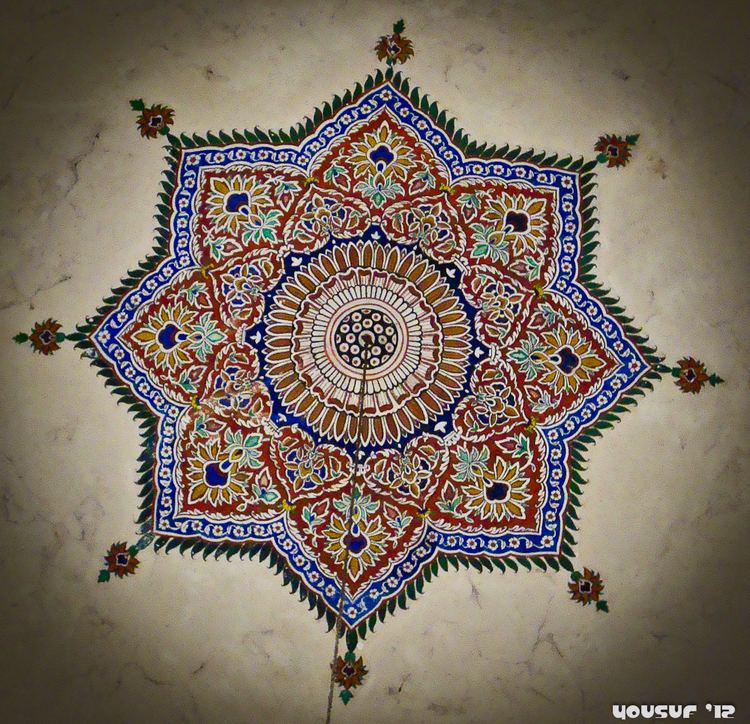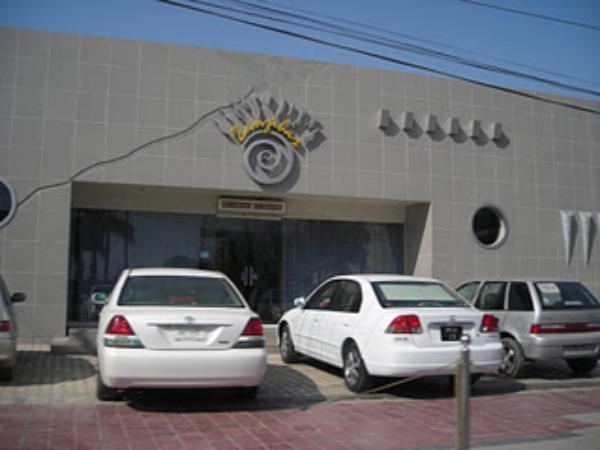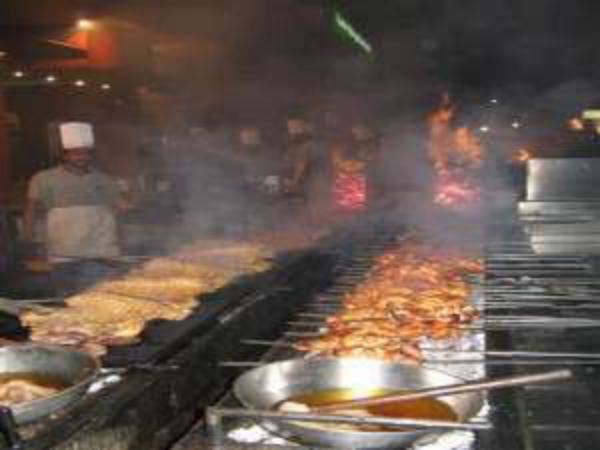Country Pakistan Elevation 710 m Area 331 km2 | Region District Multan District Population 6 million | |
Colleges and Universities Bahauddin Zakariya University, Allama Iqbal Open University, Nishtar Medical College, NFC Institute of Engineering and Technology, Government College of Technology Multan | ||
Multan (Urdu: ?) ( ), also known as city of saints, is a city of Punjab, Pakistan. It is Pakistans fifth largest city by population and has an area of 133 square kilometres (51 sq mi). The city is located on the banks of the Chenab River in the geographic center of the country.
Contents
- Map of Multan
- A road trip of multan city
- Top 10 cities of punjab pakistan lahore sargodha multan
- History
- Geography and climate
- Economy
- Culture
- Cuisine
- Traditional food multan20 dec 2013
- Dunya tv15072011traditional foods of multan latest news tv
- References
Map of Multan
Multan is known as the City of Sufis or City of Saints and Madinat-ul-Auliya because of the large number of shrines and Sufi saints from the city. The city is blanketed with bazaars, mosques, shrines, and ornate tombs. It is the birthplace of Fariduddin Ganjshakar (popularly known as "Baba Farid"), recognized as the first major poet of the Punjabi language. Multan is located in a bend created by five rivers of central Pakistan. The Sutlej River separates it from Bahawalpur and the Chenab River from Muzaffar Garh.One of the oldest Cities in the world dating back 6000 years, The city has grown to become an influential political and economical center for the country, with a dry port and excellent transport links. Multan is famous for its crops: wheat, cotton and sugar cane, mangoes, citrus, guavas, and pomegranates.
A road trip of multan city
Top 10 cities of punjab pakistan lahore sargodha multan
History
Multan is one of the oldest cities not only in the Asian subcontinent but also in the world dating back 6000 years when it was known as Maloha, a cultural and trade hub between Central Asia, South Asia and Persia. According to Hindu legends, it was the capital of the Trigarta Kingdom at the time of the Mahabharata war, ruled by the Katoch Dynasty. Multan has had various names over the years. According to Hindu mythology, it was originally called Kashtpur (Kashyapapura) after a Hindu sage named Kashyapa, which is also the Gotra used by the Katoch dynasty. Other names were Hanspur (Hamsapura), Bagpur (Vegapura), Sanb or Sanahpur (Sambapura). It has been postulated that the current name is derived from the Sanskrit name Mulasthana named after a Sun Temple. Multan has frequently been a site of conflict due to its location on a major invasion route between South Asia and Central Asia. It was conquered by Alexander the Great in 326 BC.
In the mid-5th century CE, the city was attacked by a group of Hephthalite nomads led by Toramana.
Multan was conquered along with Sindh by Muhammad bin Qasim, from the local ruler Chach of Alor circa 712 AD.Following bin Qasims conquest, the city was securely under Muslim rule, although it was in effect an independent state and most of the subjects were non-Muslim.
In 965 CE, Multan was conquered by Halam b. Shayban, an Ismaili dai. Soon after, Multan was attacked by Mahmud of Ghazni, destabilizing the Ismaili state. Mahmud of Ghazni invaded Multan in 1005 CE, conducting a series of campaigns during which the Ismailis of Multan were massacred. In an effort to gain his allegiance, the Fatimid Ismaili Imam-caliph al-Hakim dispatched an envoy to Mahmud two years later. This attempt appeared to be unsuccessful and the Ghaznawids continued to attack other Ismaili strongholds in Sindh to suppress any resurgence of the community in the region. In 1032CE Mahmuds very own vizier, Hasanak was executed for having accepted a cloak from the Imam-caliph on suspicions that he had become an adherent of the Ismaili faith. Mahmuds purges of the region led several scholars including Stern to believe that the Ghaznawid purges of the region drove out Ismailism from the area, however recently discovered letters dating to 1083 and 1088 demonstrate continued Ismaili activity in the region, as the Imam-caliph Mustansir dispatched new dais to replace those who were killed in the attacks.
Multans location at the entrance to the sub-continent resulted in it being invaded by a long series of conquerors on their way to Delhi. Timur, Babur and many others passed through the city, leaving much destruction in their wake. This violence continued as when Muhammad of Ghor attacked the city and drove out the remaining Ismailis whom he deemed to be heretics, in stark contrast to his predecessor, the Ghurid Sultan Ala al-Din who welcomed numerous envoys from the Ismaili state of Alamut and according to the historian Juzjani, gave them "great reverence" Following annexation to Mughal empire in 1557 CE, at the beginning of emperor Akbars rule; Multan enjoyed 200 years of peace, and became known as Dar al-Aman (Abode of Peace). Akbar was known as a wise ruler, setting reasonable taxes, creating effective government and being tolerant of religious differences.
Multan witnessed difficult times as Mughal rule declined in early 1700s, starting after death of emperor Aurangzeb in 1707. The last Naib Subahdars appointed by Farrukhsiyar at Multan were Khan Zaman Khan Ali Asghar ibn Kartalab Khan Bahadur Shahi Qazi Ghulam Mustafa and then Aqidat Khan ibn Ameer Khan. In 1747, Ahmad Shah Durrani—who was born in Multan—rose to power. This counts as beginning of Durrani Empire. He captured Multan in 1752.
In 1758, the Marathas under Raghunathrao captured Multan along with Lahore, Attock, Peshawar and Kashmir.
The city was re-captured by Durrani in 1760. However, after death of Ahmad Shah Durrani in 1772, the influence of Durrani empire declined sharply in mere fifty years. Starting at late in 1700s, Multan was ruled locally by the Pashtun Sadozai and Khogyani aka Khakwani chieftains.
In 1817, Maharaja Ranjit Singh sent a body of troops to Multan under the command of Diwan Bhiwani Das to receive from Nawab Muzaffar Khan the tribute he owed to the Sikh Darbar. In 1818, Kharak Singh and Hindu Commander Diwan Misr Chand armies lay around Multan without making much initial headway. Maharaja Ranjit Singh sent a large cannon named Zamzama . Though in name Armies was commanded by Prince Kharak Singh however it was the military genius of Diwan Misr Chand which captured Multan Fort.
Muzzafar Khan urged the Majority Muslim population of Multan to fight a holy war against Sikhs and Hindus, however the tactics of Muzzafar Khan failed miserably as Sikh armies were able to suppress the religious revolt of Multan population. In the battle Diwan Misr Chand led Sikh armies to a decisive victory over Durrani General of Multan Nawab Muzaffar Khan. Muzzafar Khan and seven of his sons were killed before the Multan fort finally fell on 2 March 1818. The death of Durrani General Nawab Muzzafar Khan brought the death of Muslim rule in Multan. After the defeat of Muslims in 1818, Multan came under Muslims only when British Empire divided India into two Portion and gave Muslim majority areas to Muslims in 1947. Kharak Singh left Jodh Singh Ramgarhia with 600 men to guard the fort of Multan. The Sikhs thereafter ruled Punjab until 1849, when it was lost in the Second Anglo-Sikh War.. Sardar Karan Narains son was awarded the title Rai Bahadur and knighted by the British Raj for switching to their side. After the Anglo-Sikh Wars, Multan was made part of the British Raj. The British built some rail routes to the city, but its industrial capacity was never developed. Muhammad Basher Ahmed Amretsri was revolted many time against British Government and died there.Choudy Ayzed Habib Arain and choudry Israr are the grandson of him. The predominantly Muslim population supported Muslim League and Pakistan Movement. After the independence of Pakistan in 1947, the minority Hindus and Sikhs migrated to India while the Muslim refugees from India settled in Multan. It initially lacked industry, hospitals and universities. Since then, there has been some industrial growth, and the citys population is continually growing. But the old city continues to be in a dilapidated state, and many monuments wear the effects of the warfare that has visited the city.
Geography and climate
The city of Multan is located in Punjab. The nearest major cities are Dera Ghazi Khan and Bahawalpur. The area around the city is a flat, alluvial plain and is ideal for agriculture, with many citrus and mango farms. There are many canals that cut across the Multan District, providing water from nearby farms. This makes the land very fertile. However land close to the Chenab River is usually flooded in the monsoon season.
Multan features an arid climate (Koppen climate classification BWh) with very hot summers and mild winters. The city witnesses some of the most extreme weather in the country. The highest recorded temperature is approximately 54 °C (129 °F), and the lowest recorded temperature is approximately ?1 °C (30 °F). The average rainfall is roughly 186 millimetres (7.3 in). Dust storms are a common occurrence within the city.
Economy
Multan is a commercial and industrial centre, as it is connected with the rest of the country through rail and air including the other industrial hubs such as Lahore, Karachi, Gujranwala, Quetta and Faisalabad. Industries include fertilizer, cosmetics, glass manufacturing, cotton production and processing, large textile units, flour mills, sugar and oil mills and large-scale power generation projects. It is famous for its handicrafts (carpets and ceramics) and cottage industries. Roughly 1,900 acres (7.7 km2) of the city is forested. Trees grown in the area are Kikar, Shisham and mulberry.
Culture

There is a saying in Persian that Multan is the City of Saints, Sufis and Beggars (Gard, Garma, Gada o Goristan). It is one of the main cities in the southern Punjab province of Pakistan. The city has been a focal point for many religions, in particular becoming a central abode for Sufism, the mystical side of Islam. It has attracted Sufi saints from far places of the globe. Today, Multan is known as the City of Sufis. Multan is one of the oldest cities in South Asia, with many tombs, shrines, temples, cathedrals and mausoleums, as well as a historical fort. Multan is now a combination of old and the new Pakistan culture.

There is a big hustle bustle in the old city and comforts of a five-star hotel and fine dining. The old city has bazaars selling mystical artifacts, perfumes, arts, and crafts. There are elaborately decorated shrines of the Sufi saints, tombs of travelers and important people in the old city of Multan.
The prime attractions of Multan are its mausoleums of Sufi saints. The Mausoleum of Sheikh Baha-ud-Din Zakariya, as well as the Mausoleum of Shah Rukn-e-Alam are the prime attractions. Their lofty domes oare visible from miles and dominate the skyline. Another popular shrine is the Mausoleum of Shams-ud-Din, commonly known as Shah Shamsuddin Sabzwari, located about half a mile to the east of the Multan Fort, on the high bank of the old bed of the Ravi River.
Another famous mausoleum of a warrior Sufi saint and poet Hazrat Hafiz Muhammad Jamal Multani (1747–1811 AD) is near Aam Khas garden outside Daulat Gate.
There are other mausoleums in the city that gather a great deal of attention. The Nuagaza tombs are shrines to martyrs and warriors who fought in wars centuries ago, some dating back 1,300 years. The Multan Museum has a vast collection of coins, medals, postage stamps of the former State of Bahawalpur, manuscripts, documented inscriptions, wood carvings, camel-skin paintings, historical models and stone carvings of the Islamic and pre-Islamic periods.
Multan old mosques that were once considered as the jewels of the city. Some have been dated to over 1,000 years ago and have been recognized as some of the oldest mosques in southeast Asia. The legend goes that the first mosque ever built in Multan was the Jamia Mosque which was constructed on the orders of General Mohammed Qasim, who conquered Multan in 712A D. Ruins of this mosque were visible till 1954 at Qasim Bella; however, due to repeated floods, the structure was lost. Sawi Mosque is supposed to be the oldest mosque which exists today, though in deteriorating state; there are glazed blue tiles from the era when it was built that dates the mosque to several centuries ago. The second oldest mosque in Multan is Mohammad Khan Wali Mosque. It is an excellent condition, in the busiest Chowck Bazar. It was built by Nawab Ali Mohammad Khan Khakwani in 1757 when he was the governor of Multan in the time of Alamgir II. The mosque is provided with a reservoir for ablutions, baths, and a large hall for prayers.
Multan has traditionally been a melting pot of distinct ethnic groups due to its location at the intersection of all four of Pakistans main provinces and due to its historical significance as a centre of learning and culture. As a result, Multan consists of Punjabi, Baloch, Pashtun, Sindhi, Haryanvi and Urdu speaking people.
Multan is home of the Faysal Bank T20 Cup team: Multan Tigers. The city government inaugurated the new Multan Cricket Stadium, replacing Ibn-e-Qasim Bagh Stadium which was the lone one used for football and cricket matches. The inauguration of the new stadium has allowed the city to offer Test day/night matches as well as other national sports such as hockey, badminton and football. The stadium is home to the Multan Cricket Association. Other sports grounds include Divisional Sports Ground and the Pakistan Cricket Board owned Government College Cricket Ground.
Cuisine

Multan is full of bazaars, mosques, shrines and plenty of places to have food. Restaurants serve array of cuisines including Pakistani, continental, fast, Arabic, BBQ and Chinese foods. Restaurants in Multan range from multinational chains like KFC, Subway, Pizza Hut, Hardees, and Burger King to local places like Shahjahan Grill, Bundu Khan, MUX Lounge, and Restaurant Zanzibar. Some famous cuisines of the city are the Multani mutton chops and a special dessert named "Sohan halwa".

Two special sweet rotis, very common and famous among Multani families, are doli roti and busri.
